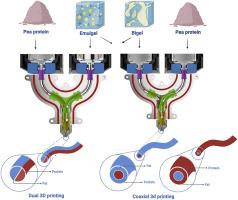Printability and interfacial performance of emulsion gels and bigels in multi-material dual and coaxial food 3D printing
IF 11
1区 农林科学
Q1 CHEMISTRY, APPLIED
引用次数: 0
Abstract
Structured fats like emulsion gels and bigels have emerged as promising animal fat substitutes for plant-based meat analogs. This study investigated the printability, rheological behavior, and interfacial compatibility of emulsion gels and bigels in combination with pea protein isolate (PPI) for extrusion-based single- and multi-material dual and coaxial 3D food printing (3DFP). Rheological analysis confirmed that despite having both systems exhibiting shear-thinning and thixotropic behavior, bigels demonstrate higher mechanical strength (G’ = 1000 Kpa vs 10 Kpa) and structural integrity (yield stress = 500 Pa vs 200 Pa). These properties translated into better print fidelity, with bigels maintaining defined structures across a range of temperatures (30–60 °C) in single-material 3DFP while emulsion gels were prone to phase separation, deformation and collapsing. In multi-material 3DP with PPI, bigels consistently demonstrated clear material separation, forming distinct core-shell structures in coaxial setups as well as maintaining well-defined, evenly distributed phases in dual extrusion. In contrast, emulsion gels exhibited smearing, irregular distribution, and poor interfacial definition in both setups, indicating weaker phase stability and compatibility with the protein matrix. Confocal laser scanning microscopy confirmed better interfacial phase boundaries between bigels and PPI, aligning with rheological and printing outcomes. In conclusion, bigels show high promise as multi-functional structuring agents and fat substitutes in multi-material 3DFP, while emulsion gels require further optimization to enhance their print performance and material compatibility.

乳化凝胶和凝胶在多材料双、同轴食品3D打印中的打印性能和界面性能
像乳化凝胶和凝胶这样的结构脂肪已经成为植物性肉类类似物的有前途的动物脂肪替代品。本研究研究了乳液凝胶和凝胶与豌豆分离蛋白(PPI)联合用于挤压单材料和多材料双轴和同轴3D食品打印(3DFP)的可打印性、流变行为和界面相容性。流变学分析证实,尽管这两种体系都表现出剪切变薄和触变行为,但bigels具有更高的机械强度(G′= 1000 Kpa vs 10 Kpa)和结构完整性(屈服应力= 500 Pa vs 200 Pa)。这些特性转化为更好的打印保真度,在单材料3DFP中,biggel在30-60°C的温度范围内保持固定的结构,而乳液凝胶容易发生相分离、变形和坍塌。在使用PPI的多材料3d打印中,bigels始终表现出清晰的材料分离,在同轴设置中形成独特的核壳结构,并在双挤压中保持明确,均匀分布的相。相比之下,乳液凝胶在两种设置中都表现出涂抹,不规则分布和界面清晰度差,表明相稳定性和与蛋白质基质的相容性较弱。共聚焦激光扫描显微镜证实了bigels和PPI之间更好的界面相边界,与流变学和打印结果一致。综上所述,凝胶作为多功能结构剂和脂肪替代品在多材料3DFP中具有很大的应用前景,而乳液凝胶的打印性能和材料相容性有待进一步优化。
本文章由计算机程序翻译,如有差异,请以英文原文为准。
求助全文
约1分钟内获得全文
求助全文
来源期刊

Food Hydrocolloids
工程技术-食品科技
CiteScore
19.90
自引率
14.00%
发文量
871
审稿时长
37 days
期刊介绍:
Food Hydrocolloids publishes original and innovative research focused on the characterization, functional properties, and applications of hydrocolloid materials used in food products. These hydrocolloids, defined as polysaccharides and proteins of commercial importance, are added to control aspects such as texture, stability, rheology, and sensory properties. The research's primary emphasis should be on the hydrocolloids themselves, with thorough descriptions of their source, nature, and physicochemical characteristics. Manuscripts are expected to clearly outline specific aims and objectives, include a fundamental discussion of research findings at the molecular level, and address the significance of the results. Studies on hydrocolloids in complex formulations should concentrate on their overall properties and mechanisms of action, while simple formulation development studies may not be considered for publication.
The main areas of interest are:
-Chemical and physicochemical characterisation
Thermal properties including glass transitions and conformational changes-
Rheological properties including viscosity, viscoelastic properties and gelation behaviour-
The influence on organoleptic properties-
Interfacial properties including stabilisation of dispersions, emulsions and foams-
Film forming properties with application to edible films and active packaging-
Encapsulation and controlled release of active compounds-
The influence on health including their role as dietary fibre-
Manipulation of hydrocolloid structure and functionality through chemical, biochemical and physical processes-
New hydrocolloids and hydrocolloid sources of commercial potential.
The Journal also publishes Review articles that provide an overview of the latest developments in topics of specific interest to researchers in this field of activity.
 求助内容:
求助内容: 应助结果提醒方式:
应助结果提醒方式:


